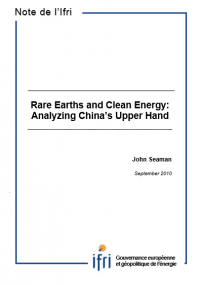Gateway to Think Tanks
| 来源类型 | Publications - Policy Papers |
| 规范类型 | 简报 |
| DOI | 978-2-86592-771-5 |
| Rare Earths and Clean Energy: Analyzing China's Upper Hand Notes de l'Ifri, September 2010 | |
| John SEAMAN | |
| 发表日期 | 2010-09-14 |
| 出版年 | 2010 |
| 概述 | An ominous resource crunch in the so-called “rare earth elements” is now threatening the development of a number of key industries from energy to defense to consumer electronics. As key components in the latest generation of technologies, including specialized magnets for windmills and hybrid... |
| 摘要 |
Rare Earths and Clean Energy: Analyzing China's Upper Hand Notes de l'Ifri, September 2010
An ominous resource crunch in the so-called “rare earth elements” is now threatening the development of a number of key industries from energy to defense to consumer electronics. As key components in the latest generation of technologies, including specialized magnets for windmills and hybrid cars, lasers for range finders and “smart” munitions, and phosphors for LCD screens, demand for these rare metals is expected to grow rapidly in the years to come.  But decades of underinvestment in the mining and separation of these elements across the globe has left the industry ill-prepared to meet this growing demand. Over the years, only China has recognized the strategic significance of these resources and has succeeded in gaining a near monopoly on production, currently churning out 97% of the world’s rare earth oxides. Faced with problems of its own, and eager to use its resource advantage to master higher levels of value-added production of rare earth-dependent products, China has increasingly limited the rest of the world’s access to these raw materials. This only complicates what was already projected to be a problematic resource shortage. This issue demands a higher quality of public debate. Rare earth consuming countries outside of China have only recently become aware of their dependence and started to take stock of the risks. Time is of the essence. Bringing new supplies online to meet growing demand is a long, complicated and risky process but is nevertheless necessary to ensure the development of high tech industries, notably clean energy. Accessible reserves of rare earths do exist outside of China and mitigating the effects of the looming shortage requires opening up these reserves to production. Yet, as the Chinese experience attests, there are substantial risks to the environment associated with mining and separating rare earths. Care must be taken to ensure responsible mining practices across the globe. Longer-term solutions, such as recycling programs, increased efficiency in resource use and the development of alternatives to rare earths are important endeavors and should be pursued, but they should not be substitutes for developing rare earth supplies outside of China today.
Rare Earths and Clean Energy: Analyzing China's Upper Hand
|
| 关键词 | Geoeconomics Rare earths China |
| URL | https://www.ifri.org/en/publications/enotes/notes-de-lifri/rare-earths-and-clean-energy-analyzing-chinas-upper-hand |
| 来源智库 | French Institute of International Relations (France) |
| 引用统计 | |
| 资源类型 | 智库出版物 |
| 条目标识符 | http://119.78.100.153/handle/2XGU8XDN/415424 |
| 推荐引用方式 GB/T 7714 | John SEAMAN. Rare Earths and Clean Energy: Analyzing China's Upper Hand Notes de l'Ifri, September 2010. 2010. |
| 条目包含的文件 | ||||||
| 文件名称/大小 | 资源类型 | 版本类型 | 开放类型 | 使用许可 | ||
| sans_titre_11.png(27KB) | 智库出版物 | 限制开放 | CC BY-NC-SA |  浏览 | ||
| noteenergieseaman.pd(827KB) | 智库出版物 | 限制开放 | CC BY-NC-SA | 浏览 | ||
除非特别说明,本系统中所有内容都受版权保护,并保留所有权利。